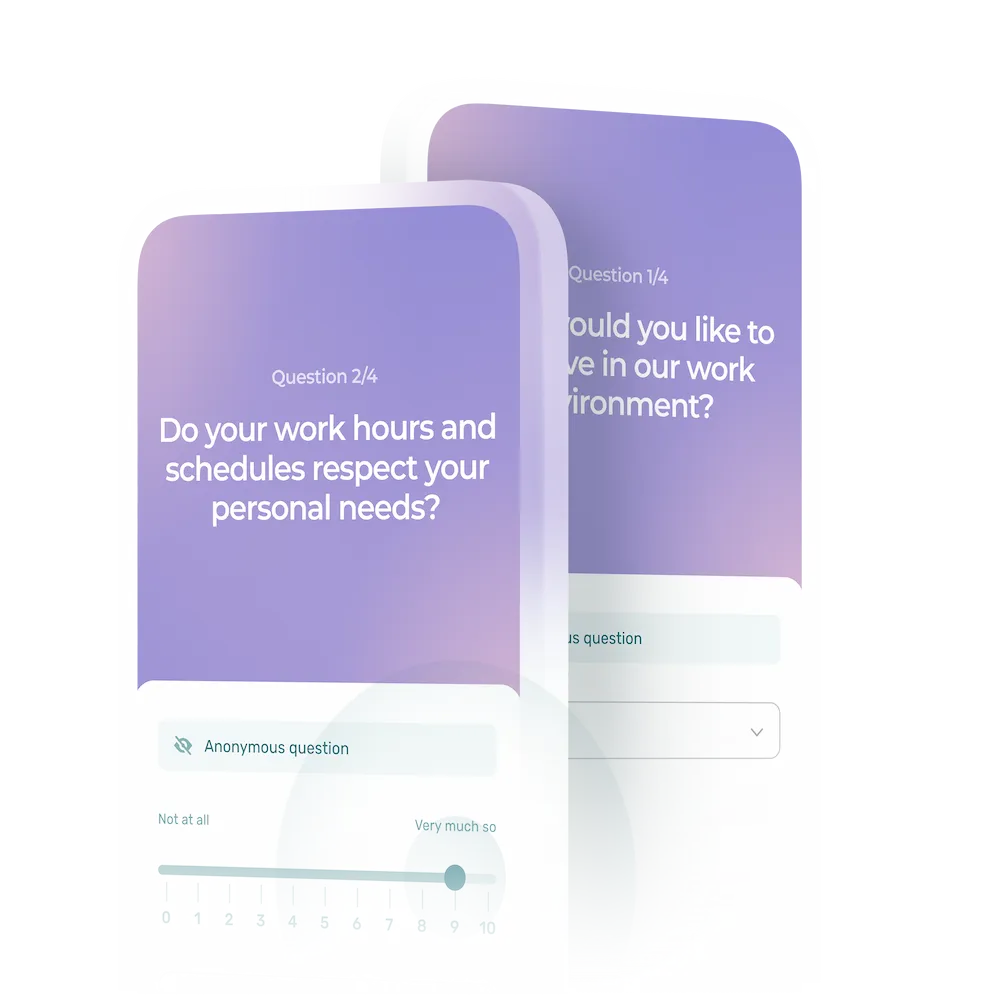Conflict is a normal and commonplace part of life and work. This being said, resolving conflict at work can be especially challenging since it often involves delicate situations.
Whether you’re an employee, a manager or an entrepreneur, at some point in time, you’ve probably found yourself in a conflict—and unsure of what to do.
According to a French study, employees lose an average of 3 hours of work to conflicts every week, which adds up to 20 days per year. And according to a study by The Myers-Briggs Company, managers spend over 4 hours per week dealing with conflict. Knowing how to deal with conflict at work is a key skill for any manager.
While there’s no shortage of advice on conflict management out there, it can be easy to get overwhelmed. So, I’ve decided to put together some concrete examples and solutions that you can check out to get inspired and find what will work for you.
Conflicts Between Employees
Conflicts between team members erupt even in the healthiest of work environments. It is completely normal for some people not to get along so well, either because of their personality or the way they work.
However, it is your role as a manager to help your employees resolve their conflicts, especially when they can no longer work together effectively. Never let the work environment deteriorate—it’s up to you to be proactive and address the issue!
Did you know that employees who experience conflict at work report lower job satisfaction and often feel less included in their team? This usually leads to a drop in performance and productivity.
To better manage employee conflict, you can:
- Act without delay when you become aware of a conflict on your team
- Organize team-building activities to promote team cohesion
- Listen to your team members and take their opinions into account
- Remain neutral in conflicts between your employees
1. Personalities That Don’t Mix
Sammy is a very cheerful, outgoing person. She loves being the centre of attention and tends to talk a lot while she works.
William is more introverted and mostly keeps to himself. He has always preferred to work alone and likes to have things done his way.
The two employees do not get along well. William doesn’t like how Sammy speaks loudly, while Sammy finds William to be a cold person. Their conflicting personalities make for a bad working atmosphere.
As a manager, your role is to mediate the conflict. Don’t let their personality conflict fester. Try to help them understand that they need to learn to work together and stop focusing only on the irritants.
If nothing works, you can also try adjusting work schedules so that these two employees won’t have to interact too often and end up getting on each other’s nerves and undermining the morale of the rest of the team.
For example, you might decide to use rotating schedules to create optimal, more balanced work teams and minimize conflict. This solution is easy to apply with scheduling software.
💡 Consider employees’ respective personalities in your recruitment process to make sure your team members have complementary strengths.
2. Conflicts Between Departments
Imagine that you’re a manager at a restaurant. The cooks and waiters aren’t getting along at all. They are constantly arguing during meal service.
The waiters are endlessly blaming the cooks when there are mistakes in the orders. The cooks are doing their best, but the order tickets are often not clear and the waiters won’t admit to their mistakes.
As a manager, it is up to you to resolve the situation and cool things down. Take the time to listen to the views on both sides and implement solutions based on the information you gathered.
Feel free to schedule formal team meetings, do more one-on-one meetings for a while, or send an anonymous questionnaire to better understand what is going on.
For example, if the order system is confusing, make any necessary changes to facilitate your teams’ work. You can also encourage your waiters to talk to the cooks directly when they get complicated orders, and vice versa.
Also, don’t hesitate to offer more training to employees to prevent mistakes from occurring. Make sure that your waiters are able to use the system properly and that all your employees use appropriate language with each other.
💡 Send your employees satisfaction questionnaires to detect any conflicts before they get out of hand.
Manager-Employee Conflicts
When you’re faced with a conflict with an employee, it can be much more difficult to address it since you are personally involved in the situation.
To manage this type of conflict effectively, you need to do a bit of soul searching, admit your mistakes and be proactive. You also need to be able to keep your emotions in check and maintain respectful interactions with the employee.
To better tackle a manager-employee conflict, you can:
- Ask a colleague or the HR manager for help
- Develop your emotional intelligence
- Keep track of your actions in the employee record
- Have a caring attitude
3. Scheduling Problems
Alexander calls to let you know that he won’t be able to come in to his shift tomorrow at the pharmacy. He forgot to tell you that he has to retake an exam for college and this is the only time he can do it.
You are irritated because Alexander could have told you in advance so you would have more time to find a solution. Despite your frustration, you understand that school comes before work.
You explain to him that this behavior is not optimal and that there’s no problem if he needs to take time off—but he needs to notify you as soon as he knows. Since this is the first time Alexander has done anything like this, you are understanding and tell him that you will find a replacement.
To do so, you open your scheduling software and send all your available employees a notification regarding Alexander’s shift. Fortunately, Cindy volunteers to replace him. All’s well that ends well.
💡 Note down the incident in Alexander’s employee record. Include what happened and how you handled the incident.
4. A Disappointing Performance
For some time now, it seems like Max hasn’t been at his best. He’s often spaced out, making mistakes and arriving late. His change in behavior is starting to affect the rest of the team, which often has to fix his mistakes or work harder to serve customers.
You decide to meet with him to find out what’s going on. You explain that you’ve noticed that he hasn’t been doing so well lately, but that his performance at work is starting to have repercussions on the rest of the team. As a manager, it is your responsibility to make sure the team is working smoothly.
As you speak with Max, you start to understand that his family life is not going well. You suggest that he uses his leave bank and take a few days off. You also remind him that the company offers support to employees who are experiencing difficult situations, in the form of a completely anonymous employee assistance program.
💡 Meet with your employees on a more regular basis to build trust and have time to discuss potentially problematic situations.
Employer-Employee Conflicts
Employer-employee conflicts are typically about issues over which the manager has little or no control. It might be a disagreement about the policies in place or the salary range for a position, for example.
More serious problems such as workplace discrimination, harassment or violence also fall into the employer’s court since all employers are required, by law, to eliminate any such situations at their organization.
Your role as a manager is to be able to explain company decisions to your employees and enforce the policies in place with your team.
To better manage an employer-employee conflict, you can:
- Use clear language
- Communicate transparently
- Create a bond of trust with your employees
- Build a strong company culture
- Recognize your employees’ work
- Help develop a sense of belonging among your team members
5. Salary-Related Disagreements
Emma’s performance evaluation didn’t go quite as she expected. She was anticipating a substantial raise, but this did not happen.
Instead, you offered her a more modest increase that was in line with the company’s salary range for her position. The meeting did not end well and you feel that Emma did not take your decision positively. However, you believe the proposed salary increase to be both fair and reasonable.
It is therefore your responsibility to explain your decision and the company’s position regarding her salary. Don’t hesitate to ask an HR representative to support you in your response, and refer to the established salary scale, if applicable.
Also take the time to explain to Emma that her salary will continue to evolve over time and that she still has great opportunities for career advancement at your company. Discuss her salary ambitions with her so that you can help her move toward her personal goals.
💡 Conduct performance evaluations several times a year rather than annually, so that your employees get more feedback.
6. Workplace Violence
Audrey comes to you, with a shaky voice, to explain that Stacy has just yelled at her and threatened her for not doing her job when she was simply helping another co-worker in the back room. She knows she has nothing to be ashamed of, but she was very afraid that Stacy would become violent.
Audrey is clearly shaken up. You suggest that she calm down in your office and ask her to explain the situation. You also ask an HR representative to join the discussion.
You realize that Stacy has been aggressive and you know that this is not the first time she has behaved this way. In fact, you had to suspend her not long ago for using foul language with colleagues.
You decide to give Audrey the rest of the day off to recover. Next, you ask Stacy to come to your office to get her side of the story.
She gets angry, starts calling you names and denies having been threatening toward Annabelle. You decide to ask her to go home for the rest of the week to cool off and prevent the situation from getting unravelling.
After watching the surveillance videos, you see that Stacy’s behavior was indeed violent and completely inappropriate. Together with the HR manager, you decide to dismiss her for gross misconduct.
💡 All companies should have a zero-tolerance policy toward violence. Be sure to inform your employees and put the necessary measures in place when this type of situation occurs.
Minimizing Conflict at Work
Workplace conflict can be minimized by fostering a caring company culture and implementing transparent management practices.
Make it a point to build trust with your employees. Don’t hesitate to do more frequent one-on-ones so that they can open up and talk about any problems they are facing.
Be proactive in managing conflicts at your workplace in order to curb their impact as much as possible.











